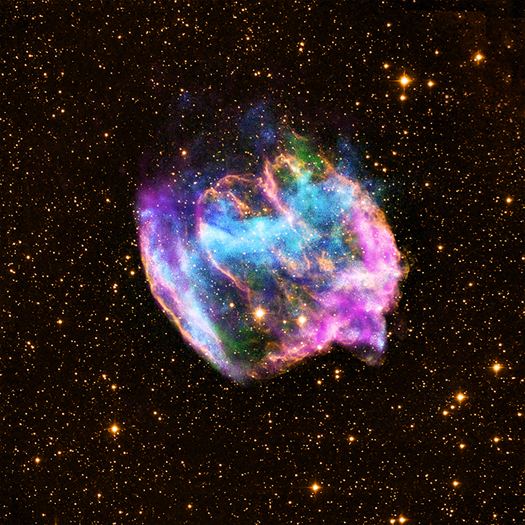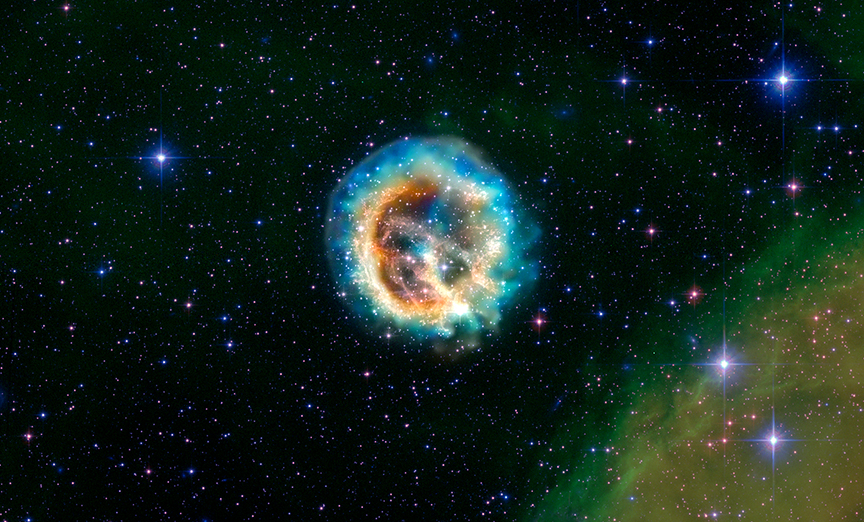Exotic Supernovas in our own Galactic Backyard

We are delighted to welcome Laura Lopez as a guest blogger today. Laura is first author of a paper describing the rare explosion that may have created the youngest known black hole in our Galaxy. Laura Lopez is currently a NASA Einstein Fellow and Pappalardo Fellow in Physics at MIT. Laura received her PhD in astronomy & astrophysics from the University of California Santa Cruz in 2011. Before her time at UCSC, she earned her bachelors degree in physics from MIT in 2004. Laura is originally from Barrington, IL, a northwest suburb of Chicago. Her research focuses on probing the beginning and ending of the stellar life cycle: how stars are born and how stars end their lives through supernova explosions.
A few years ago when I was a bright-eyed PhD student, I stumbled upon a press release making a provocative argument: a thousand year old supernova remnant in our Galaxy called W49B may have formed from a gamma-ray burst. Gamma-ray bursts (GRBs) are extreme supernova explosions thought to mark the end of the lives of some very massive stars, and they are the most energetic and luminous events in the Universe. Although astronomers have now found several hundred gamma-ray bursts, these explosions tend to be billions of light years away. So the claim that one may have occurred in our own Galaxy seemed astounding. It got me thinking: what would a gamma-ray burst look like after a thousand years, and what would it leave behind?
Astronomers believe GRBs are explosions of massive stars (ones more than 25 times the mass of the Sun) after they have exhausted their nuclear fuel. Without nuclear fusion to support the star, the core collapses to form a black hole while the outer layers of the star are thrown into space. In most supernova explosions that form a black hole, all the core material is pulled into the newly collapsed object. However, if the core of the star rotates rapidly (with one rotation every five millseconds!), then some of the heavy core metals can be expelled in jets at the poles of the star at velocities near the speed of light. And should these jets be pointed directly at Earth, the energy of the explosion is beamed into a tremendous flash of light known as gamma-ray bursts.
One thousand years later, the remnant of a gamma-ray burst would look different from a more run-of-the-mill supernova. For starters, a typical supernova is relatively spherical (i.e., the metals explode evenly in every direction, as in the supernova remnant E0102 shown in the image), whereas a gamma-ray burst should have jets full of heavy metals. By contrast, after a thousand years, the jets would have expanded and be seen as a "bar" with large amounts of iron (see image of W49B). Typical core-collapse supernovae do not produce nearly as much iron, so by measuring the amount of iron, chromium, and manganese compared to other elements in a supernova, we can assess whether W49B did arise from a gamma-ray burst.
With this goal, we observed W49B with the Chandra X-ray Observatory Advanced CCD Imaging Spectrometer (ACIS). Chandra gives us the capability to map and compare the amount of the metals produced in the explosion. Because those metals are so hot (around 10 million degrees), they emit copious X-rays. The Chandra images reveal that W49B does have a "bar" of iron, and the data shows that the relative amount of silicon and sulfur is much less than what theory predicts for a typical core-collapse supernova. Thus, the shape and metals of W49B show the explosion has the jets we associate with gamma-ray bursts.
Chandra also allows us to search for the compact object leftover from the supernova. For a very massive star that has a gamma-ray burst, we expect the explosion to produce a black hole. For a less massive star (between eight and twenty times the mass of the Sun, roughly), astronomers think that the explosion would form a neutron star. Neutron stars are tiny objects (with a radius of only 10 km!), but they are expected to be very bright in X-rays when they are a thousand years old because the neutron star surface is so hot. With the superb imaging of Chandra, we looked for a neutron star, and we couldn't find anything. In fact, the deep observation allowed us to say there's no neutron star in W49B that's even 1/100 as bright as astronomers think it would be. This result supports the fact that W49B’s supernova formed a black hole, which is consistent with the explosion having been a gamma-ray burst.
So, did W49B result from a gamma-ray burst? Probably not, since the jets weren't pointed toward us. In other words, given that we see the "bar" of iron that was the jet, it means the explosion happened perpendicular to our view from Earth. However, the explosion of W49B’s progenitor star does have all the telltale signs of a gamma-ray burst, and it probably would have looked like a GRB if the jets were oriented toward Earth. This result means that these exotic explosions can happen within our own Galaxy, and further study of W49B will give great insights into how these awesome events come about.
Category:
- Log in to post comments


